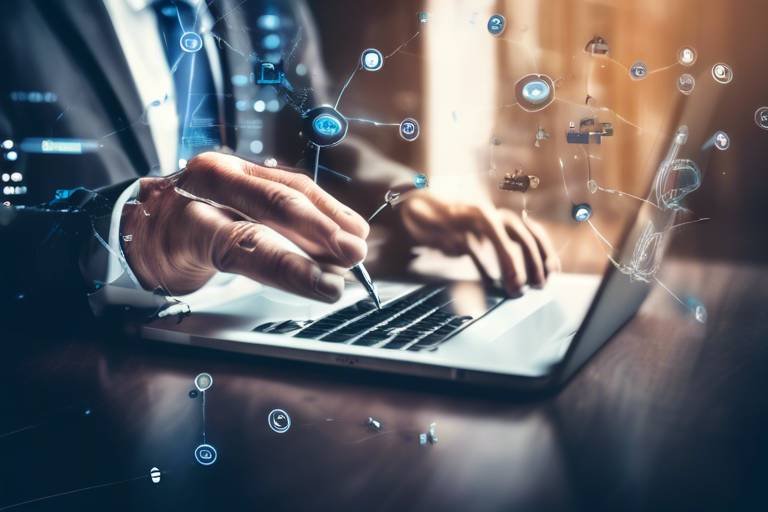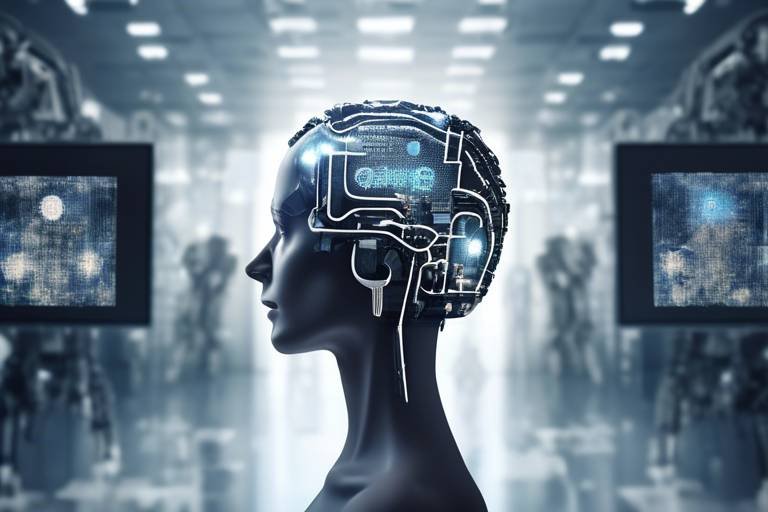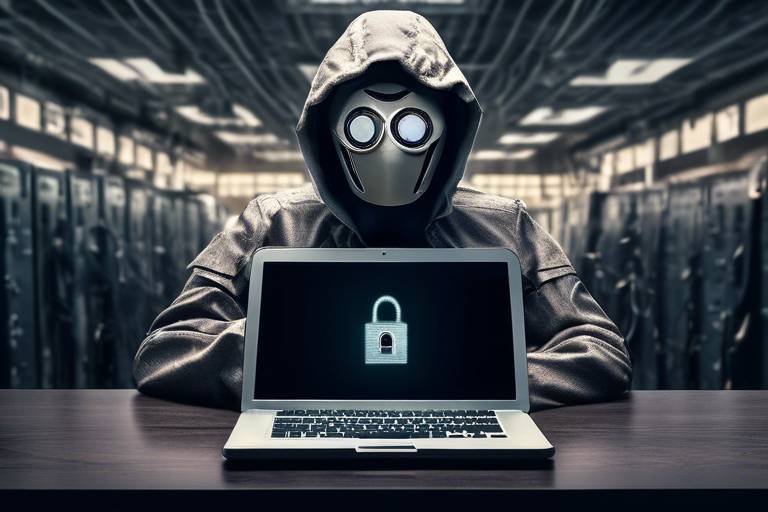The Impact of Cybersecurity on Individual Privacy
In today's digital age, the relationship between cybersecurity and individual privacy is more intricate than ever. As we navigate through an online world filled with convenience and connectivity, we often overlook the lurking dangers that come with it. Have you ever stopped to think about how your personal data is being protected—or worse, compromised? This article dives deep into the complex interplay between cybersecurity measures and the protection of individual privacy, shedding light on how security protocols can both shield and infringe upon our personal information.
The reality is that while cybersecurity aims to protect sensitive information from cyber threats, it can also lead to unintended consequences that may infringe on personal privacy. For instance, the very systems designed to keep us safe often require extensive data collection and monitoring, raising questions about how much of our personal information is truly secure. In this article, we will explore various aspects of cybersecurity, including its importance, types of cyber threats, and the role of encryption—all of which play a crucial part in defining our privacy landscape.
To truly grasp the impact of cybersecurity on individual privacy, it’s essential to understand the myriad of cyber threats that exist today. From malware to phishing attacks, these threats not only jeopardize our personal information but also challenge our sense of security in the digital realm. By identifying and understanding these threats, we can develop effective strategies to mitigate their impact and protect our privacy.
As we delve deeper into the various types of cyber threats, it becomes clear that knowledge is power. By arming ourselves with information about the tactics used by cybercriminals, we can better defend ourselves against potential breaches. So, how do we strike a balance between robust cybersecurity measures and the preservation of our individual privacy? Let’s explore this multifaceted issue together.
Cybersecurity is not just a technical concern; it is a vital component of our daily lives. With the increasing reliance on technology, understanding the significance of cybersecurity helps individuals recognize the need for robust protection measures to maintain their privacy. Consider this: every time you log into a social media account, shop online, or even send an email, you are entrusting your personal information to various platforms. This trust can easily be shattered if the right cybersecurity measures are not in place.
Moreover, the importance of cybersecurity extends beyond personal safety; it also affects businesses, governments, and society as a whole. A significant breach can lead to financial loss, reputational damage, and even legal ramifications. Therefore, it is imperative for everyone to be proactive in safeguarding their information and understanding how cybersecurity can both protect and potentially infringe upon their privacy.
When we talk about cyber threats, we're referring to a broad spectrum of malicious activities that can compromise individual privacy. Here are some of the most common types:
- Malware: Malicious software designed to harm or exploit any programmable device or network.
- Phishing: Fraudulent attempts to obtain sensitive information by disguising as a trustworthy entity.
- Ransomware: A type of malware that locks users out of their files and demands payment for access.
Understanding these threats is crucial for developing effective strategies to mitigate their impact on personal data. The more informed we are, the better equipped we become to deal with these challenges, ensuring that our privacy remains intact in an ever-evolving digital landscape.
Encryption serves as a cornerstone in the realm of cybersecurity, playing a significant role in enhancing individual privacy. By securing data transmission, encryption ensures that sensitive information remains confidential and protected from prying eyes. But how does encryption actually work? In simple terms, it transforms readable data into an unreadable format, which can only be deciphered by those who possess the appropriate key.
Understanding encryption is empowering. It allows individuals to take charge of their data security and make informed decisions about the tools they use. For example, when communicating sensitive information online, using encrypted messaging apps can provide an additional layer of security. So, how can we make the most of encryption to safeguard our privacy?
Q: What is cybersecurity?
A: Cybersecurity refers to the practices and technologies designed to protect computers, networks, and data from unauthorized access, damage, or theft.
Q: How does encryption enhance privacy?
A: Encryption protects data by converting it into a format that is unreadable without the correct key, ensuring that even if data is intercepted, it cannot be easily accessed.
Q: What are some common cyber threats?
A: Common threats include malware, phishing, and ransomware, all of which can compromise personal data and privacy.
Q: How can I protect myself from cyber threats?
A: Implementing strong passwords, using antivirus software, and being cautious with emails and links can significantly enhance your security.

The Importance of Cybersecurity
In our hyper-connected world, where we share personal information with just a click, cybersecurity has become more than just a buzzword; it's a necessity. Imagine walking down a busy street with your wallet wide open, exposing all your private information to anyone passing by. That’s essentially what navigating the internet without proper security measures feels like. Cybersecurity is essential for safeguarding sensitive information from cyber threats, ensuring that your personal data remains private and secure.
Understanding the significance of cybersecurity can be likened to wearing a seatbelt while driving. Just as a seatbelt protects you in case of an accident, robust cybersecurity measures protect you from potential online threats. With the rise of data breaches and identity theft, acknowledging the need for these protective measures is crucial. A single lapse in security can lead to devastating consequences, including financial loss and personal information exposure.
Moreover, the digital landscape is constantly evolving, with cybercriminals becoming more sophisticated in their tactics. This makes it imperative for individuals to stay informed and proactive. Here are a few reasons why cybersecurity is vital:
- Protection of Personal Information: Cybersecurity helps safeguard sensitive data, such as social security numbers, bank account details, and personal identification.
- Maintaining Privacy: With effective cybersecurity measures, individuals can control who has access to their personal information, thereby enhancing their privacy.
- Preventing Financial Loss: Cyber threats can lead to significant financial losses. Implementing cybersecurity can help mitigate these risks.
In essence, cybersecurity is not just about protecting devices; it's about protecting lives. As we dive deeper into the digital realm, the importance of being vigilant and adopting strong cybersecurity practices cannot be overstated. By recognizing its significance, individuals can take the necessary steps to fortify their online presence, ensuring that their private information remains just that—private.

Types of Cyber Threats
In today's digital age, understanding the various is crucial for anyone who wants to safeguard their personal information. The internet, while a treasure trove of opportunities, also harbors a dark underbelly of malicious activities that can compromise individual privacy. Cyber threats come in many forms, each with its unique methods and impacts. By recognizing these threats, individuals can take proactive measures to protect themselves and their data.
One of the most prevalent threats is malware, a term that encompasses a variety of malicious software designed to infiltrate and damage systems. Malware can take many forms, including viruses, worms, and spyware, each with its own modus operandi. For instance, viruses attach themselves to clean files and spread throughout a computer system, while spyware secretly collects information from users without their consent. The consequences can be devastating, leading to identity theft, loss of sensitive data, and significant financial repercussions.
Another major threat is phishing, a technique that exploits human psychology to trick individuals into divulging personal information. Phishing attacks often come in the form of seemingly legitimate emails or messages that prompt users to click on malicious links or provide sensitive information. These scams can be incredibly convincing, often mimicking trusted organizations. The key to defending against phishing lies in vigilance and skepticism—if something feels off, it's essential to double-check before taking any action.
Additionally, there's ransomware, a particularly insidious type of malware that locks users out of their own systems until a ransom is paid. Imagine waking up one day to find that all your important files have been encrypted, and the only way to access them again is to pay a hefty sum to a faceless criminal. This scenario is a harsh reality for many individuals and businesses alike. Ransomware attacks can lead to not only financial loss but also emotional distress and reputational damage.
To further illustrate these threats, here's a quick comparison table:
| Type of Cyber Threat | Description | Impact |
|---|---|---|
| Malware | Malicious software designed to harm or exploit any programmable device or network. | Data loss, identity theft, system damage. |
| Phishing | Fraudulent attempts to obtain sensitive information by disguising as a trustworthy entity. | Data breaches, financial loss, loss of privacy. |
| Ransomware | Malware that encrypts files and demands payment for their release. | Financial loss, data loss, operational disruption. |
In conclusion, being aware of these cyber threats—malware, phishing, and ransomware—can empower individuals to take necessary precautions. The digital landscape is fraught with dangers, but with the right knowledge and tools, you can navigate it safely. Always remember to stay informed, keep your software updated, and think critically before clicking on links or sharing personal information. In a world where your data is often more valuable than gold, protecting it should be a top priority.
- What is the most common type of cyber threat? Malware is often considered the most common cyber threat, as it encompasses a wide range of malicious software.
- How can I protect myself from phishing attacks? Always verify the sender's email address, avoid clicking on suspicious links, and use security software that can detect phishing attempts.
- What should I do if I've been a victim of a ransomware attack? Disconnect your device from the internet immediately, report the incident to authorities, and consider seeking professional help for data recovery.

Malware and Its Effects
Malware, short for malicious software, is a term that encompasses various types of harmful programs designed to infiltrate and damage computers and networks. Its effects can be devastating, especially when it comes to individual privacy. Imagine waking up one day to find that your personal information, such as passwords, bank account details, and even private conversations, have been compromised. This nightmare scenario is a reality for many who fall victim to malware attacks.
So, how does malware work? It can sneak into your device through seemingly innocent downloads, email attachments, or even through vulnerabilities in software. Once inside, it can operate silently, collecting data without your knowledge. This is where the danger lies: users often remain oblivious to the fact that their privacy is being invaded until it's too late. The consequences can range from identity theft to financial loss, making it imperative to understand the implications of malware on personal privacy.
To illustrate the impact of malware, let's consider some common types:
- Viruses: These are designed to replicate and spread to other devices, often corrupting files and causing system failures.
- Spyware: This type of malware secretly monitors user activity and collects sensitive information, such as login credentials.
- Ransomware: A particularly alarming form of malware that encrypts files and demands payment for their release, often leaving victims in a state of panic.
Understanding these types of malware is crucial for developing effective strategies to protect against them. The first step in safeguarding your privacy is awareness. By recognizing the signs of a potential malware infection—such as unexpected system slowdowns, strange pop-up ads, or unfamiliar programs appearing on your device—you can take action before the situation escalates.
Moreover, the effects of malware extend beyond just personal privacy. They can also lead to significant financial repercussions, not only for individuals but also for businesses that may suffer from data breaches. The fallout can include legal fees, loss of customer trust, and even regulatory fines. Therefore, it's essential to treat malware as a serious threat to both individual and organizational privacy.
In conclusion, the effects of malware on individual privacy are profound and far-reaching. By being informed and proactive, individuals can protect themselves from the potential devastation that malware can cause. Remember, the best defense is a good offense—stay vigilant and secure your digital life!

Common Types of Malware
When we talk about malware, we’re diving into a world filled with digital nasties designed to wreak havoc on our devices and steal our personal information. Understanding the common types of malware is crucial for anyone who wants to stay safe in the digital landscape. Let’s explore some of the most prevalent forms of malware that individuals should be aware of:
- Viruses: These are perhaps the most well-known type of malware. They attach themselves to clean files and spread throughout a computer system, often causing damage and corrupting files. Just like a virus in the biological sense, they can replicate and infect other systems.
- Spyware: This sneaky software operates quietly in the background, collecting data about users without their consent. It can track your browsing habits, capture keystrokes, and even access sensitive information like passwords. Imagine having a hidden camera in your home, watching your every move—that's what spyware does online.
- Ransomware: This malicious software locks users out of their files or systems, demanding a ransom for access. It’s like a digital hostage situation, where the perpetrators hold your data for ransom until you pay up. The impact can be devastating, especially for individuals and small businesses.
- Trojans: Named after the infamous Trojan Horse, these malware programs disguise themselves as legitimate software. Once installed, they can create backdoors for other malicious software to enter. It’s like inviting a stranger into your home, only to find out they’ve brought along a gang of robbers.
- Adware: While not always harmful, adware can be intrusive and annoying. It bombards users with unwanted advertisements and can slow down systems. Think of it as a persistent salesperson who just won’t take no for an answer.
Each type of malware has its own unique characteristics and methods of infiltration. By familiarizing ourselves with these threats, we can better equip ourselves to recognize the signs of an infection and take proactive measures to protect our devices and personal data. It’s about being one step ahead in this ongoing battle against cyber threats. Remember, knowledge is power, and understanding these common types of malware is the first line of defense in safeguarding your privacy.
What is malware?
Malware is a broad term used to describe any software designed to harm or exploit any programmable device, service, or network. It includes viruses, spyware, ransomware, and more.
How can I protect myself from malware?
You can protect yourself by using reliable antivirus software, keeping your operating system updated, avoiding suspicious links and downloads, and regularly backing up your data.
What should I do if I think I have malware on my device?
If you suspect malware, run a full scan with your antivirus software, disconnect from the internet to prevent further damage, and consider seeking professional help if the problem persists.

Preventative Measures Against Malware
This article explores the intricate relationship between cybersecurity measures and individual privacy, discussing how security protocols can both protect and infringe upon personal data in today's digital landscape.
Cybersecurity is essential for safeguarding sensitive information from cyber threats. Understanding its significance helps individuals recognize the need for robust protection measures to maintain their privacy in an increasingly connected world.
Various cyber threats, such as malware, phishing, and ransomware, pose significant risks to individual privacy. Identifying these threats is crucial for developing effective strategies to mitigate their impact on personal data.
Malware can compromise individual privacy by allowing unauthorized access to personal information. Understanding its mechanisms helps users take proactive steps to protect themselves from potential breaches.
Different types of malware, including viruses and spyware, have unique ways of infiltrating systems. Familiarity with these types can aid individuals in recognizing and avoiding potential threats.
When it comes to defending against malware, being proactive is key. Think of your digital life as a house; you wouldn’t leave the front door wide open, would you? Similarly, implementing a robust security strategy can help keep your personal information safe from prying eyes. Here are some effective preventative measures:
- Install Reliable Antivirus Software: This acts as your first line of defense. A good antivirus program can detect and neutralize malware before it has a chance to wreak havoc on your system.
- Regularly Update Software: Keeping your operating system and applications up to date ensures that you have the latest security patches. Just like a car needs regular maintenance, your devices require updates to run smoothly and securely.
- Be Wary of Unknown Links: Phishing attempts often come disguised as legitimate emails. Always double-check the URL before clicking on links, and if something feels off, trust your instincts!
- Use Strong, Unique Passwords: Think of your password as the key to your digital house. Make it complex and unique to prevent unauthorized access. Consider using a password manager to help keep track of them.
- Backup Your Data: In case of a malware attack, having a backup of your important files can save you from significant data loss. Use cloud services or external hard drives to keep your data safe.
By taking these steps, individuals can significantly enhance their privacy and security against malware threats. Remember, the goal is to create multiple layers of defense, much like a fortress protecting its inhabitants.
Phishing attacks manipulate individuals into revealing personal information. Recognizing the tactics used in these scams is vital for protecting one’s privacy in the digital space.
Encryption plays a significant role in enhancing individual privacy by securing data transmission. Understanding how encryption works can empower individuals to better protect their sensitive information online.
Different encryption methods, such as symmetric and asymmetric encryption, offer various levels of security. Knowing these types helps individuals choose the right encryption tools for their needs.
Adopting best practices for encryption, including using strong passwords and secure key management, can significantly enhance the privacy of personal data against cyber threats.
1. What is malware?
Malware is malicious software designed to harm, exploit, or otherwise compromise a computer system or network.
2. How can I tell if my device is infected with malware?
Signs of infection may include slow performance, frequent crashes, unexpected pop-up ads, or unfamiliar programs appearing on your device.
3. Is antivirus software enough to protect me?
While antivirus software is essential, it should be part of a broader security strategy that includes regular updates, strong passwords, and cautious online behavior.
4. What should I do if I suspect a phishing attempt?
Do not click on any links or provide personal information. Report the email to your email provider and delete it immediately.
5. How often should I update my passwords?
It’s a good idea to change your passwords every three to six months, especially for sensitive accounts.

Phishing Attacks Explained
Phishing attacks are a sneaky and often devastating way that cybercriminals manipulate individuals into revealing their personal information, such as passwords, credit card numbers, and social security details. Imagine walking down the street and someone hands you a seemingly official-looking document, asking for your most sensitive information. Sounds absurd, right? But that's essentially what phishing does in the digital world. These attacks can come in various forms, including emails, text messages, or even phone calls, all designed to look legitimate and trustworthy.
One of the most common tactics used in phishing is creating a false sense of urgency. For instance, you might receive an email that claims your bank account will be suspended unless you verify your details immediately. This tactic plays on our instincts to react quickly, often leading to hasty decisions that compromise our privacy. Cybercriminals are masters of deception, using logos and language that mimic real companies, making it increasingly difficult for the average person to discern between genuine communication and a scam.
To better understand how these attacks operate, let’s break down some key characteristics of phishing:
- Deceptive Communication: Emails or messages that appear to be from reputable sources.
- Urgency or Threats: Messages that create a sense of panic to provoke immediate action.
- Links to Fake Websites: Links that lead to fraudulent websites designed to capture sensitive information.
Phishing attacks can also evolve into more sophisticated forms, such as spear phishing, where attackers target specific individuals or organizations, often using personal information to make their messages more convincing. This tailored approach can be particularly dangerous, as it exploits the trust and familiarity that the victim may have with the attacker. Think of it as a wolf in sheep's clothing; the more they know about you, the easier it is for them to manipulate you.
Recognizing the signs of phishing is crucial in protecting your privacy. Here are a few tips to help you stay one step ahead of these cyber threats:
- Check the Sender's Email Address: Look for subtle misspellings or unusual domains.
- Hover Over Links: Before clicking, hover your mouse over links to see the actual URL.
- Verify with the Source: If in doubt, contact the company directly using official channels.
By staying informed and vigilant, you can significantly reduce the risk of falling victim to phishing attacks. Remember, your personal information is like gold in the digital world, and it’s essential to guard it fiercely. Just as you wouldn’t give your house keys to a stranger, don’t hand over your sensitive data without verifying the request. The more you know about these tactics, the better equipped you’ll be to protect your privacy in an increasingly complex digital landscape.
Q: What should I do if I think I've been phished?
A: If you suspect you've fallen victim to a phishing attack, immediately change your passwords, enable two-factor authentication, and monitor your accounts for any suspicious activity.
Q: Can I report phishing attempts?
A: Yes, you can report phishing emails to your email provider and to organizations like the Federal Trade Commission (FTC) or the Anti-Phishing Working Group.
Q: Are phishing attacks only conducted through email?
A: No, phishing can occur through various channels, including SMS (smishing), voice calls (vishing), and even social media platforms.

The Role of Encryption
In our digital age, the concept of encryption has become a crucial pillar for protecting individual privacy. But what exactly is encryption? At its core, encryption is the process of converting information or data into a code, making it unreadable to anyone who doesn't possess the key to decrypt it. This means that even if a cybercriminal intercepts the data during transmission, they will be unable to make sense of it without the proper decryption key. Think of it like sending a secret message in a language only you and your friend understand; even if someone else sees it, they won't have a clue what it says!
Encryption not only secures your data but also instills a sense of trust in the digital environment. When you see that little padlock icon in your browser's address bar, it signifies that the website is using encryption to protect your information. This is particularly important when you’re entering sensitive details, such as credit card numbers or personal identification. Without encryption, such information is vulnerable to interception by malicious actors, potentially leading to identity theft or financial loss.
There are various types of encryption, each serving different purposes and levels of security. For instance, symmetric encryption uses the same key for both encryption and decryption, which can be efficient but poses a risk if the key is compromised. On the other hand, asymmetric encryption employs a pair of keys—a public key for encryption and a private key for decryption. This method enhances security since the private key never needs to be shared. Understanding these differences can help individuals make informed decisions about which encryption methods to use for their sensitive data.
Moreover, employing encryption isn't just about the technology; it also involves adopting best practices. For example, using strong passwords and regularly updating them is essential for maintaining the integrity of your encryption keys. Secure key management is another critical aspect; if someone gains access to your encryption keys, they can easily decrypt your data, rendering the whole process ineffective. Thus, being proactive about encryption can significantly bolster your defenses against cyber threats.
In summary, encryption plays a pivotal role in safeguarding individual privacy in an increasingly digital world. By understanding how it works and implementing effective encryption strategies, individuals can protect their sensitive information from prying eyes and potential breaches. Remember, in the vast ocean of the internet, encryption is your lifebuoy, keeping you afloat while navigating through the waves of cyber threats.
- What is encryption? Encryption is the process of converting data into a coded format to prevent unauthorized access.
- Why is encryption important for privacy? It secures sensitive information during transmission, making it unreadable to anyone without the decryption key.
- What are the types of encryption? The main types include symmetric encryption (same key for encryption and decryption) and asymmetric encryption (public and private keys).
- How can I enhance my encryption security? Use strong passwords, manage your keys securely, and regularly update your encryption methods.

Types of Encryption
When it comes to safeguarding our digital lives, understanding the is essential. Encryption is like a digital lock that secures your information, ensuring that only those with the right key can access it. There are two main categories of encryption: symmetric and asymmetric. Each type has its unique characteristics and applications, making them suitable for different scenarios.
Symmetric encryption uses the same key for both encryption and decryption. This means that the sender and receiver must share the secret key beforehand. Think of it as having a single key to a treasure chest; both parties need to keep that key safe. Popular algorithms that utilize symmetric encryption include AES (Advanced Encryption Standard) and DES (Data Encryption Standard). These algorithms are widely used for encrypting data at rest, such as files stored on your hard drive or cloud storage.
On the other hand, asymmetric encryption employs a pair of keys: a public key and a private key. The public key can be shared with anyone, while the private key is kept secret by the owner. This is akin to having a mailbox where anyone can drop in letters (using the public key), but only the mailbox owner can open it and read the letters (using the private key). Asymmetric encryption is commonly used in secure communications, such as SSL/TLS protocols that protect your online transactions.
Both types of encryption serve crucial roles in protecting our data, but they also come with their own sets of advantages and disadvantages. For instance, symmetric encryption is generally faster and more efficient for encrypting large amounts of data. However, the challenge lies in securely sharing the key between parties. Asymmetric encryption, while more secure in terms of key distribution, can be slower and requires more computational power.
To illustrate the differences between these two encryption types, here’s a simple comparison table:
| Type of Encryption | Key Usage | Speed | Common Algorithms |
|---|---|---|---|
| Symmetric | Same key for encryption and decryption | Faster | AES, DES, RC4 |
| Asymmetric | Public and private key pair | Slower | RSA, ECC, DSA |
Understanding these types of encryption helps individuals make informed decisions about their data security. Whether you’re encrypting sensitive emails or securing your online transactions, knowing which encryption method to use can significantly enhance your privacy and protect your personal information from cyber threats.

Best Practices for Using Encryption
This article explores the intricate relationship between cybersecurity measures and individual privacy, discussing how security protocols can both protect and infringe upon personal data in today's digital landscape.
Cybersecurity is essential for safeguarding sensitive information from cyber threats. Understanding its significance helps individuals recognize the need for robust protection measures to maintain their privacy in an increasingly connected world.
Various cyber threats, such as malware, phishing, and ransomware, pose significant risks to individual privacy. Identifying these threats is crucial for developing effective strategies to mitigate their impact on personal data.
Malware can compromise individual privacy by allowing unauthorized access to personal information. Understanding its mechanisms helps users take proactive steps to protect themselves from potential breaches.
Different types of malware, including viruses and spyware, have unique ways of infiltrating systems. Familiarity with these types can aid individuals in recognizing and avoiding potential threats.
Implementing antivirus software and regular system updates are effective strategies for preventing malware infections, thereby enhancing individual privacy and security.
Phishing attacks manipulate individuals into revealing personal information. Recognizing the tactics used in these scams is vital for protecting one’s privacy in the digital space.
Encryption plays a significant role in enhancing individual privacy by securing data transmission. Understanding how encryption works can empower individuals to better protect their sensitive information online.
Different encryption methods, such as symmetric and asymmetric encryption, offer various levels of security. Knowing these types helps individuals choose the right encryption tools for their needs.
To truly harness the power of encryption, it's essential to adopt best practices that not only secure your data but also enhance your overall privacy. One of the first steps is to ensure that you are using strong passwords. A weak password can be the Achilles' heel of even the most robust encryption. Aim for passwords that combine letters, numbers, and special characters, and consider using a password manager to keep track of them.
Another critical practice is secure key management. This means ensuring that your encryption keys are stored safely and are not easily accessible to unauthorized users. Think of your encryption key as the key to your house; if someone else has it, they can enter without your permission. Regularly changing your keys can also add an extra layer of security.
Additionally, it's important to keep your encryption software up to date. Just as you would update your phone or computer to protect against the latest threats, encryption tools also need regular updates to fix vulnerabilities. Failing to do so can leave your data exposed, much like leaving your front door wide open.
Lastly, always be cautious about where and how you share sensitive information. Even with encryption, sharing data over unsecured networks can be risky. Use a Virtual Private Network (VPN) when transmitting sensitive data, as this adds an additional layer of encryption to your online activities. By integrating these best practices into your digital life, you can significantly enhance your privacy and security against cyber threats.
- What is encryption? Encryption is the process of converting information or data into a code to prevent unauthorized access.
- Why is encryption important for privacy? It secures sensitive information during transmission, making it difficult for unauthorized parties to access or interpret the data.
- How can I ensure my encryption is effective? Use strong passwords, secure key management practices, keep your software updated, and be cautious about sharing sensitive information.
Frequently Asked Questions
- What is cybersecurity and why is it important?
Cybersecurity refers to the practices and technologies designed to protect networks, devices, and data from unauthorized access or attacks. It's crucial because, in our digital world, sensitive information can easily fall into the wrong hands, leading to identity theft, financial loss, and privacy violations.
- What are some common types of cyber threats?
Common types of cyber threats include malware, phishing, ransomware, and denial-of-service attacks. Each of these poses unique risks, but they all can significantly compromise your personal data and privacy if not addressed properly.
- How does malware affect my privacy?
Malware can invade your devices and allow cybercriminals to access your personal information without your knowledge. This can lead to unauthorized transactions, data theft, and even the hijacking of your online accounts.
- What are the best ways to protect against malware?
To protect against malware, you should install reputable antivirus software, keep your operating system and applications updated, and avoid downloading files or clicking on links from unknown sources. Regularly backing up your data is also a smart move!
- What is phishing, and how can I recognize it?
Phishing is a technique used by cybercriminals to trick individuals into revealing sensitive information, often through fraudulent emails or websites that appear legitimate. Look out for signs like poor grammar, generic greetings, and suspicious links to identify phishing attempts.
- How does encryption enhance my privacy?
Encryption secures your data by converting it into a code that can only be read by someone with the appropriate decryption key. This means that even if your data is intercepted, it remains unreadable to unauthorized users, thus protecting your privacy.
- What are the different types of encryption?
There are two main types of encryption: symmetric and asymmetric. Symmetric encryption uses the same key for both encryption and decryption, while asymmetric encryption uses a pair of keys—a public key for encryption and a private key for decryption. Each has its own use cases and security levels.
- What are some best practices for using encryption?
To effectively use encryption, always choose strong, unique passwords, keep your encryption keys secure, and regularly update your encryption methods to stay ahead of potential threats. It's like locking your valuables in a safe—make sure the lock is robust!



















